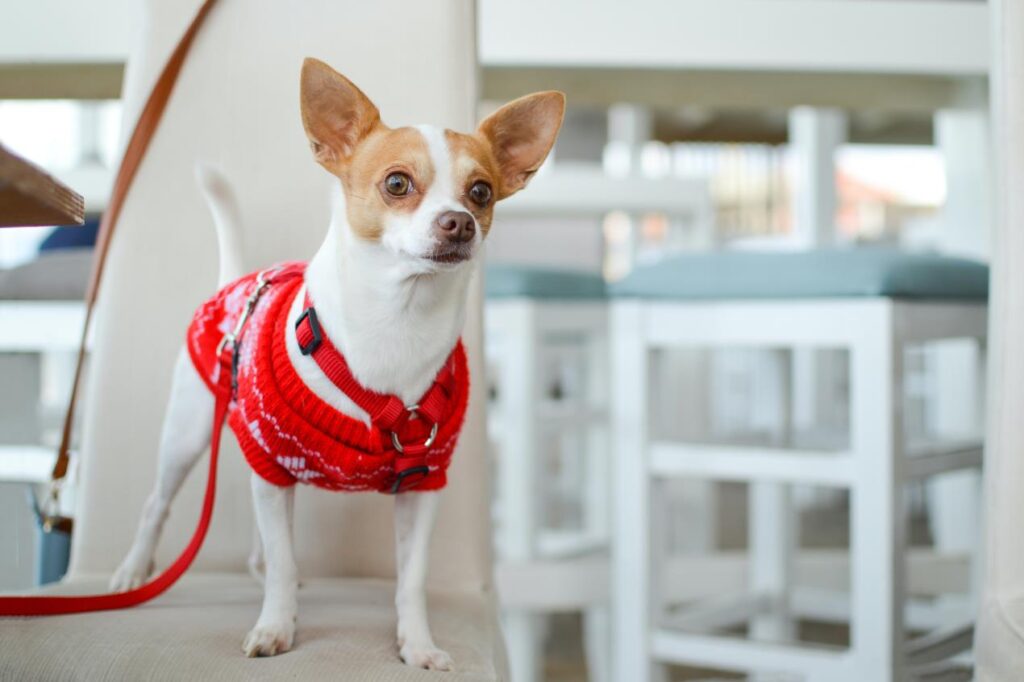Should dogs wear Christmas jumpers? One vet weighs in

For humans, noticing that a jumper is irritating simply results in some half-hearted scratching and then removing the item of clothing. However, for dogs, the reality of wearing clothing is not so simple: dogs have no way of communicating whether their skin is being irritated or not, along with having no way to remove clothing that is placed onto them.
There are many fabrics that most dogs find irritating against their skin, which is why Head Vet Sean McCormack at talis.com has revealed which ones should be avoided, how to recognise the signs of skin irritation and when clothing fits your dog incorrectly.
Head Vet Sean McCormack at tails.com shared his insight on the matter:
“With Christmas day fast approaching, it can be more tempting than ever to dress up your furry friend and get them to pose for a photo. As cute as it might look on Instagram, many dogs do not actually enjoy wearing jumpers, while others may be irritated by certain fabrics the clothes are made from.
It’s not just allergic reactions to fabrics that can be an issue, rubbing and restricting movement can also irritate your dog”
tamara-bellis-UI7xouE1dpw-unsplash
Which fabrics should I avoid when buying a jumper for my dog?
“One of the main offenders is wool. While luxurious for most humans, wool can be very irritating for dogs. Wool might seem like a good, warm choice for a dog jumper, but for pups with sensitive skin it can cause itching and discomfort.
Another fabric that might cause irritation is nylon. While nylon is a very commonly used fabric, canines who are allergic can experience itchy and inflamed skin. If your pet has toys, blankets and collars made from nylon, a jumper should also be safe.
Faux fur can be hugely itchy for certain dogs. While it is great for keeping humans warm, there is a risk of it being incredibly irritating for dogs. It could also cause dogs with thicker coats to overheat, as they are, essentially, already wearing an insulated coat.
A less obvious fabric is that of cotton blends. If an item of doggy clothing isn’t crafted from 100% pure cotton, it is usually woven with polyester or nylon – which can cause your dogs to itch.
Finally, we have feathers. If a festive costume party is on the horizon for you and your pooch, then feathers are a definite no-go. As well as presenting a potential choking hazard, feathers can be extremely irritating for dogs.
Even if feathers are not in direct contact with your dog’s skin, a jacket or coat filled with goose down could also present the same problem. Due to this, you should always check what outdoor dog clothes are stuffed with.”
What are the signs of a dog having an allergic reaction to fabric?
“If your dog is irritated or, worse, having an allergic reaction to a certain type of material, there are always signs you can look out for:
Cuts on the skin that show a dog has been scratching
Weeping eyes
Excessive scratching
Skin redness caused by scratching
Bald patches caused by hair loss
A runny nose
Itchy ears
Swelling around the face
Sneezing
Head shaking
Swelling feet
If your pooch starts to present any of the more serious signs of irritation or a reaction, such as swelling, baldness, cuts or even infections, it is essential that you take them to a vet.
In order to avoid any unnecessary stress for your furry friend, we would recommend only dressing your dogs in clothes made from pure cotton. When making a decision on whether or not to dress your pooch in a festive jumper, you should always prioritise their happiness and wellbeing. Certain dogs find wearing any sort of additional clothing extremely uncomfortable and stressful, and the feeling of annoyance can be difficult to recognise.
When making the decision, check whether your dog can move freely in the clothing. The clothing should not be restricting their movement in any way – they should be able to eat, breathe, drink and visit the toilet easily.
Make sure your dog is not wearing clothing for a long period of time. If they start to show signs of distress, remove the outfit immediately.
When the heating’s on and the house is crowded, your home can become hot and uncomfortable for your dog. If your dog has a warm jumper on, they may overheat quickly. It’s important to monitor the temperature of your home and pet, if they start to display signs of overheating, including panting and salivation then it’s a clear sign your dog is uncomfortable.
It can be difficult to read your dog’s body language, but there are key signs to recognise if your pet feels irritated when wearing clothing, including; they have their tail tucked between their legs, rubbing against furniture or excessive licking.
If your pet is wearing a fun festive jumper, then they shouldn’t be left unattended near potential hazards including a fire. Check before putting a jumper on your pets that the surrounding environment can’t cause any harm to your pet, or that the clothing itself fits correctly and won’t cause injury from snagging or discomfort.”




